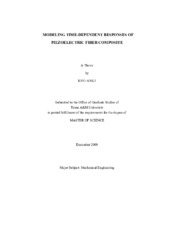| dc.description.abstract | The existence of polymer constituent in piezoelectric fiber composites (PFCs)
could lead to significant viscoelastic behaviors, affecting overall performance of PFCs.
High mechanical and electrical stimuli often generate significant amount of heat,
increasing temperatures of the PFCs. At elevated temperatures, most materials, especially
polymers show pronounced time-dependent behaviors. Predicting time-dependent
responses of the PFCs becomes important to improve reliability in using PFCs. We study
overall performance of PFCs having unidirectional piezoceramic fibers, such as PZT
fibers, dispersed in viscoelastic polymer matrix. Two types of PFCs are studied, which
are active fiber composites (AFCs) and macro fiber composites (MFCs). AFCs and
MFCs consist of unidirectional PZT fibers dispersed in epoxy placed between two
interdigitated electrode and kapton layers. The AFCs have a circular fiber cross-section
while the MFCs have a square fiber cross-section. Finite element (FE) models of
representative volume elements (RVEs) of active PFCs, having square and circular fiber
cross-sections, are generated for composites with 20, 40, and 60 percent fiber contents. Two FE
micromechanical models having one fiber embedded in epoxy matrix and five fibers
placed in epoxy matrix are considered. A continuum 3D piezoelectric element in ABAQUS FE is used. A general time-integral function is applied for the mechanical,
electrical, and piezoelectric properties in order to incorporate the time-dependent effect
and histories of loadings. The effective properties of PZT-5A/epoxy and
PZT-7A/LaRC-SI piezocomposites determined from the FE micromechanical models are
compared to available experimental data and analytical solutions in the literature.
Furthermore, the effect of viscoelastic behaviors of the LaRC-SI matrix at an elevated
temperature on the overall electro-mechanical and piezoelectric constants are examined. | en |


